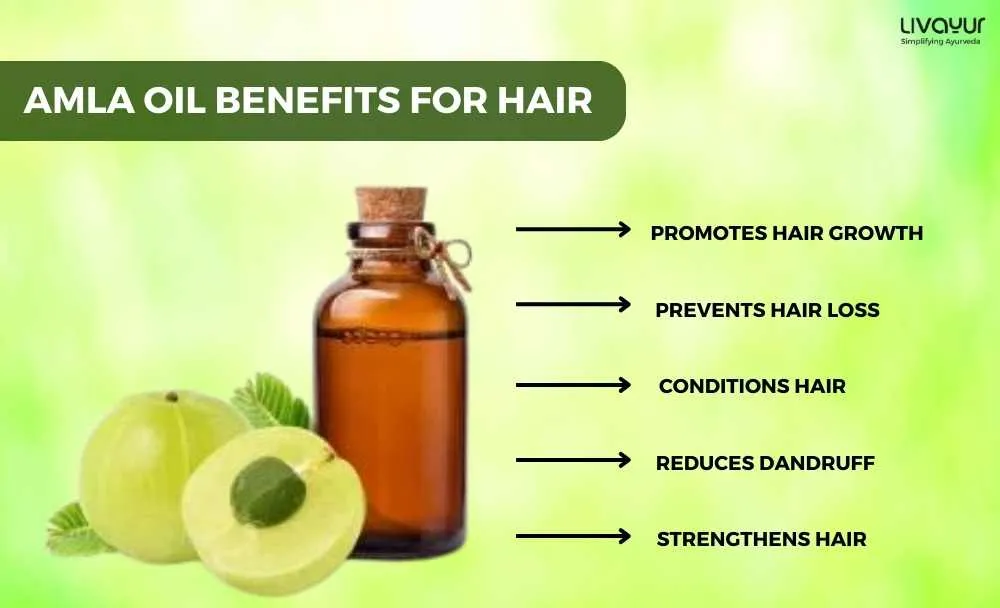
Amla oil, derived from the Indian gooseberry, is a natural remedy deeply rooted in traditional Ayurvedic medicine. Rich in vitamin C, antioxidants, and essential fatty acids, it offers numerous benefits for hair health. Here are 10 advantages of using amla hair oil: [1]
Why Use Amla for Hair Loss?
Indian gooseberry or Amla is an important herbal component of traditional recipes and acts as a hair tonic. The oil obtained from these gooseberries is used to strengthen and promote hair growth. The dried fruit, which improves hair hygiene, has long been utilized as an important ingredient of shampoo and hair oil. Thus, the Indian gooseberry is used as a hair tonic in traditional recipes for enriching hair growth and pigmentation. [2]
How Does Amla Aid Hair Care
1. Promotes Hair Growth
The fruit of the aonla tree, also known as the Indian gooseberry (Amla), is a rich source of Vitamin C, as well as other nutrients like pectin and polyphenols. These nutrients help combat free radicals that can damage hair cells. By protecting the hair follicles from oxidative stress, Amla oil supports a healthy environment for hair growth. [3]
2. Prevents Hair Loss
Hair loss can be a distressing problem, and amla hair oil comes to the rescue here as well. Its high vitamin C content strengthens hair follicles, reducing the chances of hair breakage and shedding. Regular use of amla hair oil can effectively help prevent hair loss and promote overall hair health. In addition to its nutrient content, Amla oil also has anti-inflammatory properties. This can help to reduce inflammation in the scalp, which can be a contributing factor to hair loss.
A study found that amla oil was effective in reducing dandruff and improving scalp health. This would provide additional evidence to support the claim that amla oil can help to prevent hair loss. [4]
3. Conditions Hair
Unlike many commercial hair conditioners laden with chemicals, amla hair oil is a natural conditioner that works wonders for your tresses. It softens and detangles hair, making it more manageable and reducing the risk of knots and split ends. [4]
4. Reduces Dandruff
Dandruff can be an embarrassing and uncomfortable scalp condition. Amla hair oil’s anti-inflammatory and antibacterial properties help combat dandruff and other scalp infections effectively. A healthier scalp promotes healthier hair growth. A study found that amla oil was effective in reducing dandruff and improving scalp health, and it also improved the moisture levels in the scalp. [4]
5. Prevents Premature Graying
Premature graying of hair is a common concern for many individuals. The antioxidants present in amla oil help combat free radical damage, which is often associated with premature graying. Regular application of this oil can help maintain your hair’s natural color for longer. [4]
6. Improves Scalp Health
A healthy scalp is the foundation for healthy hair. Amla hair oil boosts blood circulation in the scalp, promoting better nutrient delivery to the hair follicles. Improved scalp health can result in stronger, more resilient hair. [4]
7. Strengthens Hair
Amla hair oil’s combination of essential fatty acids and vitamins fortifies hair strands, reducing the risk of breakage and split ends. Stronger hair is less prone to damage, making it easier to maintain longer locks. [4]
8. Adds Shine to Hair
Dull and lifeless hair can be a confidence drainer, but amla hair oil has a solution for that too. Regular application of this oil imparts a natural shine to your hair, making it look healthier and more lustrous. [4]
9. Soothes Scalp Irritation
Scalp irritation and itching can be caused by various factors, including dryness and environmental pollutants. The anti-inflammatory properties of amla hair oil help soothe the scalp, providing relief from itching and irritation. [4]
10. Protects Hair from Damage
Our hair is exposed to various environmental pollutants and harmful free radicals daily. Amla hair oil’s antioxidants form a protective barrier around your hair strands, safeguarding them from potential damage and preserving their overall health. [4]
How to use amla oil for hair
Here’s a step-by-step guide on effectively using amla oil for optimal hair care.
1. Perform a patch test
To avoid allergic reactions, perform a patch test by applying a small amount of amla oil to a discrete area of your skin. Wait for a day to check for adverse reactions.
2. Prepare your hair
Start with clean, dry hair. You can use a mild, sulfate-free shampoo to remove dirt or product buildup. Towel-dry your hair gently, leaving it slightly damp for better oil absorption. Next, divide your hair to ensure the smooth application of the oil. Use hair clips to keep the areas separate.
3. Apply to your scalp
Apply the amla oil directly to your scalp using your fingertips or a cotton ball. After covering the scalp, apply the remaining oil to the length of your hair.
4. Massage and comb through
Spend a few minutes massaging your scalp to enhance absorption and stimulate hair follicles. A wide-tooth comb can help distribute the oil through the length of your hair.
5. Leave it on
Allow the amla oil to sit on your scalp for around 30 minutes to an hour. For deeper conditioning, leave it on overnight. Additionally, cover your hair with a shower cap or silk scarf.
6. Shampoo and condition
After the suggested time, wash your hair with a mild shampoo. Do it twice to ensure the removal of the entire oil. Remember to use a conditioner to maintain moisture balance.
How do you use an amla oil hair mask?
Follow these steps to create an effective amla oil hair mask for healthy locks.
1. Gather ingredients
Add ingredients like yogurt, honey, coconut oil, or an egg, depending on your hair needs. These additions can enhance the mask’s conditioning and moisturizing properties.
2. Mix the hair mask
Combine the desired amount of amla oil in a bowl with the chosen additional ingredients. Adjust the amount depending on your preferences. For example, mix 2-3 tablespoons of amla oil with 1-2 tablespoons of yogurt or honey.
3. Prepare your hair
Start with clean, damp hair. Use a mild shampoo to remove any product residue, and towel dry your hair gently. Next, divide your hair into manageable sections to ensure even mask application.
4. Apply the hair mask
Apply the amla oil hair mask to your scalp and hair using a brush. Start from the roots and work your way down to the tips.
5. Massage and distribute
Massage the mask gently into your scalp to promote blood circulation. A wide-tooth comb can help distribute the mask evenly through the length of your hair.
6. Wrap your hair
Once you apply the mask, secure your hair in a loose bun or use a shower cap to cover your hair.
7. Leave it on
Allow the amla oil hair mask to sit for at least 30 minutes to an hour. For a more intensive treatment, you can leave it on for several hours or even overnight.
8. Rinse and shampoo
After the recommended time, rinse the hair mask thoroughly with lukewarm water. Follow up with a mild shampoo to ensure the removal of residues. Next, use a conditioner for added softness, depending on your hair type.
FAQs
1. What is the best way to apply Amla Oil on the head?
Here are some great tips for using amla hair oil:
Apply amla hair oil to your scalp and hair before going to bed.
Leave the oil in your hair overnight and shampoo it out in the morning.
You can also apply amla hair oil to your hair in the morning and leave it in for a few hours before shampooing.
Use amla hair oil regularly to see the best results.
2. Are there any other Amla products besides Amla oil that can be used for hair care?
Absolutely! While Amla oil is renowned for its hair benefits, the world of Ayurvedic hair care offers several other products that can help maintain the luster of your hair. One such product is a Detox Juice containing Wheatgrass and Amla, this is an excellent solution for promoting healthy hair.
3. What is Amla oil, and how is it made?
Amla oil is a natural oil derived from the Indian gooseberry fruit, also known as Amla. It is typically made by soaking dried Amla fruits in a carrier oil, such as coconut oil or sesame oil, and then allowing it to infuse for several days.
4. How often should I use Amla oil on my hair?
It is recommended to use Amla oil at least once a week for optimal results. However, the frequency of use can vary depending on individual hair needs and concerns.
5. Can Amla oil be used alongside other hair care products?
Absolutely! Amla oil can be easily incorporated into your existing hair care routine. It complements other products and enhances their benefits.
6. Can Amla oil help with reducing frizz in the hair?
Yes, Amla oil’s conditioning properties can help in taming frizz and providing a smoother appearance to the hair.
Conclusion
Come to think of it, amla hair oil is a treasure trove of benefits for anyone seeking natural and effective hair care. From promoting hair growth to preventing premature graying, this traditional remedy has proved its worth time and again. Incorporate this ancient remedy into your hair care routine, and you’ll soon notice a positive transformation in the health and appearance of your hair.
Disclaimer: The information provided here is for general information and not meant to substitute any medical advice. Please consult your doctor for appropriate medical consultation.
Where to buy amla oil?
| Online store | Price |
| Amazon | ₹184 (450 ml) |
| Moksha | ₹166 (30 ml) |
| Flipkart | ₹47 (110 ml) |
| Vagad’s Khadi | ₹199 |
| Big Basket | ₹46.55 (90 ml) |



















